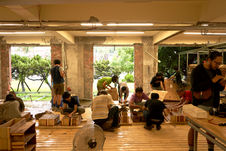
林暐翔
LIN WEI SIANG
|植物生態|
植物人、生態農耕顧問、植物生態教育研究學者、 農業耕地規劃、土壤生態系統改良、植物生態復育、植物生態工程相關授課
scroll
跨域採集研究概念
The Concept of Interdisciplinary Collecting Research
臺北沙漠土壤生態癒土壤孕育植物
植物生命滋養土地
複雜性脈絡演進!
土壤乘載眾多生命營養與質量
植物用自身世代生命及肉體逐步建構環境
都市沙漠中的植物們
受逼迫壓實的土壤們
如何堅忍的在逆境中生存修復?
如何減緩人工環境的劣化?
如何默默改善這片荒蕪?
如何幫助著生活在其中的人們?
空總軍營時期種植
喬木:樟樹、芒果、蓮霧、芭樂、龍眼、正榕、雀榕、龍柏、小葉南洋杉、 大葉合歡、柚子、大葉桉、黃椰子
灌木:金露花、矮仙丹、朱槿、圓葉榕、
草本:南美彭棋菊
而後開放空間交付管理 自然落種生長出:構樹、小果桑、茄苳、海金沙、到手香、不死鳥等 先驅植物和入侵種植物開始野放競爭演化
管理方式主要以修剪割草為主
而非養護根系改善土質
易傷及植株造成受傷傾斜病害
綠化降溫的功能性逐漸衰弱
溫測圖可看出植株處於高燒不易降溫
環境如此惡劣植株求生意志依然旺盛
待續:在地廢棄物循環利用土壤質地環境改善實驗
Taipei Desert Ecology Healing Soil cultivating plants
Life of plants nourish the complexity of its veins the earth! Soils carry many lives, nutrition and quality
The plants reduce ecological adversity and gradually construct the environment with its own life and body from its generation
Plants in the urban desert
The soils that are forced to be compacted---
How do they survive and renovate in adversity?
How to slow the deterioration of artificial environment? How to silently improve the waste?
How to help the people who is living in it?
Plants during Air Force Base period
Trees: camphor, mango, jambu fruit, guava, longan, banyan, sea fig, dragon juniper, norfolk island pine, siris tree, pomelo, swamp mahogany, yellow coconut
Shrubs: golden dew, jungle flame, China rose, thick leaved fig
Herbs: singapore daisy
Then the space was open to management
Naturally grew: paper mulberry, mulberry, red cedar, Japanese climbing fern, country borage, floppers and so on.
The pioneering plants and invasive plants begin to evolve in the wild.
跨域採集研究講座節選
The Talk Excerpt of Interdisciplinary Collecting Research
近幾年我在做的是如何讓一個生態性的演化速度加速,因為這是動物的本份。生態這個詞它其實是一個動詞,它是不斷不斷地循環,所以我們必須要先搞清楚生態的目的性。我用生態的三個目的性去看待一塊土地,若這塊土地的發展沒有往這三個目的前進,那這個環境就會比較有狀況。
第一個目的性是生物多樣性,所有的環境棲地都會慢慢往生物多樣性移動,這讓這 環境的生物種類越來越多。我在空總的一些生態復育的實驗,會讓大家看到如何用人類的廢棄物或是大家不要的東西,幫助生態做這個循環動作。生物多樣性中有一 個生態環境是我們人類完全忽略的,生物界裡面有超過百分之四十不在人類肉眼可 視的範圍,它藏在地底下。土壤生態系是人類研究非常缺乏的一個系統,但是土壤生態系的健全程度決定著一個生態系演化的速度。
再來是永續循環性,它是生態裡面非常重要的一個環節,所有東西都是在那個循環,沒有所謂的垃圾。人類建構垃圾其實某種程度就是把那個循環切斷了,但生態是沒頭沒尾的,生態是個網狀,所以出去的東西會再回來,只是回來的時間不一定很快,我們人類可以加速這個動作,所以你今天在這個場地的永續循環性是不是真 的東西都被善加利用,這件事非常重要。
再來第三個也是難度最高的,叫區域獨特性。所有的生態當它演化到一個程度的時 候,就是說所有的植物在生長到一個程度的時候,它自己把土地切割開,切出一個面或是切出一個獨立的生態區,它的獨立不是我們大家想像中的它完全分隔,它是 會有很不一樣的生態區域。同樣是一公頃的森林,它同樣有不一樣的區域,光的差異、水分的差異、濕度的差異、土壤的差異,讓不同的動物自己找得到適合生存的環境,生態演化到循環的時候,區域獨特性會很明顯的切割出來。
從空照圖來看,空總是臺北離所有可以接近到底部水域最遠的中心點,意思是說空 總幾乎決定了是這一塊區域的熱集中點。全臺灣年均溫最高的是臺北市,因為熱完 全散不出去,所以產生了一種情形叫作熱島效應。如果我們今天可以在熱源的中心 ——空總,幫它做一個降溫點,效果一定會非常好,只要我們做到兩件事:第一, 怎麼讓它把周圍的熱消耗掉?第二,怎樣讓可以吸收熱的3D構面做得更好?就是 說不是只是平面吸熱,就像樹一樣,樹是個3D吸熱系統,它除了可以吸收上面的陽光之外,連旁邊的輻射熱都可以被它吸收掉。
In recent years, I have been trying to expedite the speed of ecological evolution because it is the duty of animals. Ecology is, in fact, a verb because it refers to an endless cycle. That is why we must first understand the purpose of ecology. When looking at a piece of land, I would view it from three ecological objectives. If the development of this land is not moving towards these three objectives, this environment will probably be in trouble.
The first objective is biodiversity. All environments or habitats eventually will move towards biodiversity, which results in the increase of species. My experiments of ecological restoration at TAF will show people how to use man-made wastes or things that people throw away to facilitate the ecological cycle. In the discussion of biodiversity, there is an ecological environment that has been completely overlooked by human beings. Forty percent of the ecosystem is hidden from the human eye because it is underground. Soil ecosystem has been absent in scientific studies; however, the health of the soil ecosystem actually determines the speed of ecological evolution.
The second one is the sustainable cycle, which is a crucial part of the ecology. This cycle involves everything and creates no garbage. Man-made garbage, on a certain level, has discontinued the cycle. Yet, ecology has no beginning nor end; it is a network. So, whatever is produced will eventually return; it is just a matter of time. Human beings can indeed expedite the movement. Therefore, it is very important whether all things are used properly to ensure the sustainable cycle of this site.
The third objective, regional uniqueness, is the hardest. When an ecosystem evolves to a certain level, or when all plants in the ecosystem grow to a certain point, it will sever itself from its surrounding land and create an area, an independent ecological zone. Its independence is not a complete isolation as it sounds; instead, it is an utterly different ecological area. A forest that is one hectare in size will have different zones with variations in light, moisture, humidity and soil that allow different animals to find their own living environment. When ecological evolution enters the cycle, the regional uniqueness will become very clear.
From the aerial image, TAF is located at a center point that is farthest from all reachable bodies of water in Taipei. That means TAF is almost the heat spot of this area. Taipei City has the highest annual average temperature because the heat is trapped in the city and leads to the so-called heat island effect. If we could create a cooling point at the heat spot, that is TAF, the effect would be amazing. To achieve this, we need to do two things. The first thing is to think about how to remove the surrounding heat. The second thing is to improve the heat-absorbing three-dimensional surfaces. It means that not only the two-dimensional surfaces should absorb heat. For example, trees form a three- dimensional heat-absorbing system, which not only absorbs sunlight from the sky but also radiant heat from the surrounding environment.











